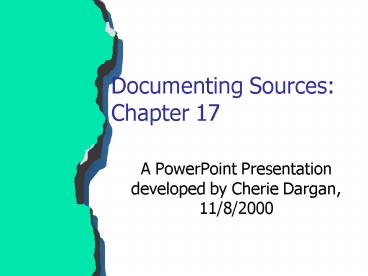Documenting Sources: Chapter 17 PowerPoint PPT Presentation
1 / 27
Title: Documenting Sources: Chapter 17
1
Documenting Sources Chapter 17
- A PowerPoint Presentation developed by Cherie
Dargan, 11/8/2000
2
Overview
- Well begin with some review from our discussion
about annotation and the Water article handout - Next, well look at the history of documentation
- Finally, well highlight chapter 17
3
Reviewthere are 3 Ways to use sources
- Summary a brief, condensed version
- Paraphrase restated in your own words (to
simplify and clarify) - Direct quote use sparingly
4
Always cite your source!
- No matter HOW you use a source (book, magazine
article, website, interview), you need to let
your reader know that it isnt your idea - Identify source to avoid plagiarism
5
What is Plagiarism?
- It is stealing someone elses ideas.
- Some people do it on purpose, while others do it
out of ignorance.
6
A short history of Documentation
- First, there were footnotes. Each time you used a
source, you had a footnote about it at the bottom
of the page. - Now, they are used only in some journals and
doctoral programs.
7
History, continued!
- Next came the endnote. This began as a way to
make it easier for writers and readers. - All of the footnotes were collected at the very
end of the document.
8
Still More History!
- Finally, we got smart. Who reads footnotes or
endnotes?? We made it even simpler. - The newest style is the in-text citation, also
called internal or parenthetical documentation.
9
3 Things You Dont Need to Acknowledge
- Common knowledge (historical facts)
- Familiar sayings (clichés like have a nice
day!) - Well known quotes (Harry Trumans saying, the
buck stops here!)
10
Bibliography
- This is the old term for a list of sources that
appears at the end of a paper. - MLA -- Works Cited
- APA -- References
- Both are alphabetical, using the authors last
name. If there is no author, use the first word
of the title.
11
Okay, lets look at chapter 17 now
12
There are two main styles
- MLA
- Modern Language Association
- Used for English, Lit, and Humanities papers
- (Post 125)
- APA
- American Psychological Association
- Used for Psychology Sociology papers
- Also called author/year style.
- (Post, 1997, p. 125)
13
MLA
- Include this information
- Authors name, title, publication source, year,
and page. - See the Hacker Handbook, Tab M, for many
examples, and a sample essay.
14
APA
- Includes all of the same information, but puts
the year after the authors name in parentheses. - Post (1997)
- See Hacker Handbook, Tab A, for examples and a
sample paper.
15
Sample entries
- See page 573 for some examples of MLA and APA
documentation styles side by side - There is a list of essays using both styles with
chapter references
16
Blending sources into your writing
- Notice the section on pages 573-574 that
discusses three strategies - Paraphrasing what does it mean and when do you
use it? - Summarizing how is it different from a
paraphrase? - Quote why is a shorter quote often better?
17
Sample passages
- See page 574
- There is an original passage
- Then a paraphrase
- Finally, a summary
18
Cite the author
- Whether you summarize, quote or paraphrase, you
need to identify, or cite, the author - You can signal this several ways
- Brown points out..
- Brown states
- According to Brown,
19
Two kinds of quotes
- Short quotes
- These can be inserted into your own sentences
- You should still indicate the quoted portion with
quotation marks
- Long quotes
- Long quotes are considered over four lines
- In your paper, you will skip the quotation marks
and set off an extra ten spaces from the left
20
More on quotes
- See the examples in the text, pages 576-578
- You can place the quote into various places in
the sentence - To shorten a quote, use ellipses (a set of
periods with a space before and after. . .) to
get rid of material not needed for your purposes
21
In-text citations
- This means that when you use a source, you should
identify it WITHIN the text - According to Dr. Smith, half of all students
procrastinate writing papers (34). - The citation is the material in parentheses this
is the page number that the information can be
found on. The author is already known.
22
Other kinds of citations
- If the author is NOT mentioned, you should
include it in the parentheses. - Half of all students procrastinate (Smith 34).
- This is an example of the MLA style of citations.
23
APA citations
- Here is that citation in APA style.
- According to Dr. Smith (1999), half of all
students procrastinate writing papers (p. 34). - If the author isnt named
- Half of all students procrastinate writing papers
(Smith, 1999, p. 34).
24
End of the document
- MLA the last page is called the Works Cited
Page - APA the last page is called References
- Both documentation styles arrange the sources in
alphabetical order, by the authors last names
25
MLA and APA Examples
- Books pages 582-587
- Articles in periodicals pages 587-589
- This includes magazines, journals, and newspapers
- Miscellaneous sources pages 589-591
- On-line and electronic sources pages 591-595
26
APA Examples On-line
- See page 595-596
- There are a variety of examples of different
kinds of sources
27
Sample APA MLA papers
- See page 598-599 for a checklist of features for
both MLA and APA style papers - A sample MLA paper is found on pages 599-609
- A sample APA paper is found on pages 610-619

